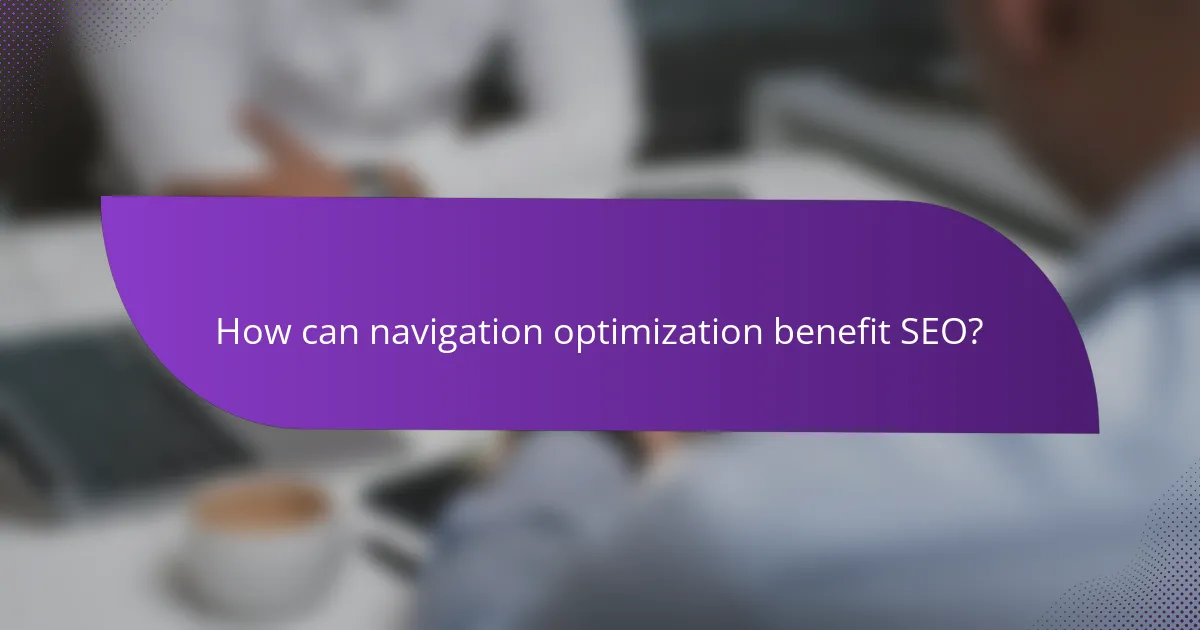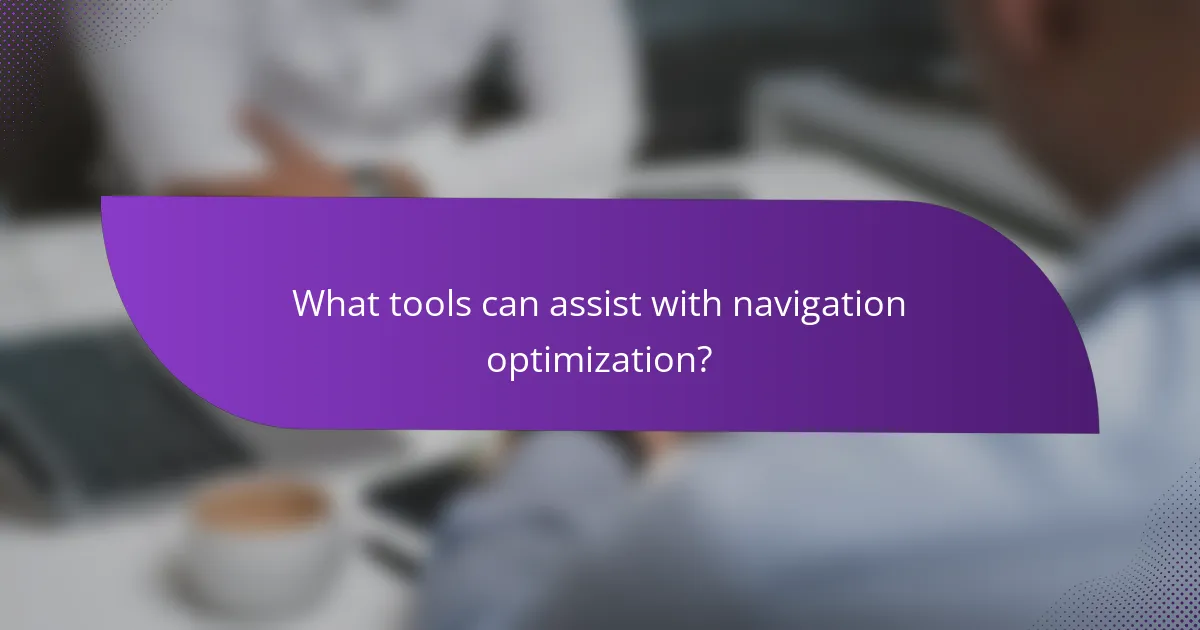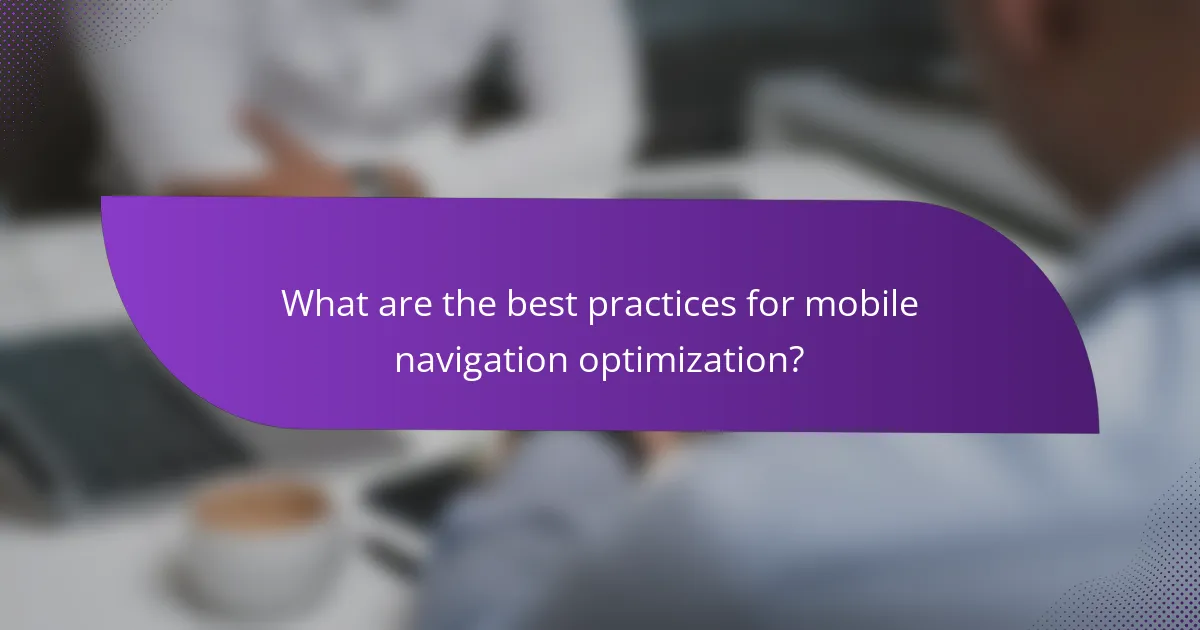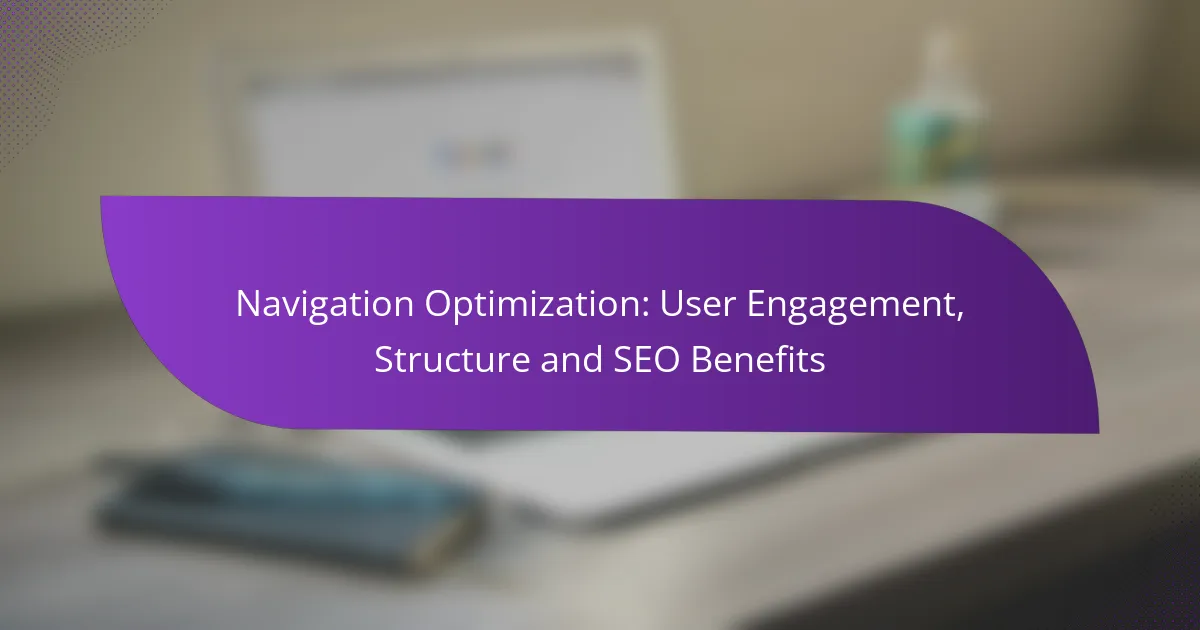Navigation optimization plays a crucial role in enhancing user engagement by streamlining the process of finding information on a website. A well-structured navigation system not only reduces user frustration but also supports SEO efforts by improving site visibility and making it easier for search engines to index content. By implementing clear hierarchies and descriptive labels, websites can create a more intuitive experience that encourages exploration and increases overall satisfaction.

How does navigation optimization improve user engagement?
Navigation optimization enhances user engagement by making it easier for visitors to find information quickly and intuitively. A well-structured navigation system reduces frustration and encourages users to explore more content, leading to a more satisfying experience.
Enhanced user experience
Improving navigation directly contributes to a better user experience by streamlining the path users take to find what they need. Clear menus, logical categorization, and intuitive design help users feel more in control and less overwhelmed. For instance, using breadcrumb trails allows users to backtrack easily, enhancing their overall satisfaction.
Consider implementing responsive design elements that adapt to various devices. This ensures that navigation remains user-friendly on smartphones, tablets, and desktops, catering to a wider audience and improving accessibility.
Increased page views
Effective navigation encourages users to explore multiple pages, significantly increasing page views. When users can easily find related content or additional resources, they are more likely to click through rather than leaving the site. For example, a well-placed sidebar with links to popular articles can entice users to delve deeper into your content.
To maximize page views, consider using engaging calls-to-action (CTAs) that guide users to explore further. Highlighting popular or relevant content can also prompt users to stay longer and browse more pages.
Lower bounce rates
Optimized navigation can lead to lower bounce rates by ensuring that users find what they are looking for without frustration. When visitors can navigate seamlessly, they are less likely to leave the site after viewing only one page. A clear and logical structure helps retain users and encourages them to interact with more content.
To further reduce bounce rates, analyze user behavior to identify common exit points and adjust navigation accordingly. Implementing features like search bars or filters can also help users quickly locate desired information, keeping them engaged longer.

What are the key elements of an effective navigation structure?
An effective navigation structure includes a clear hierarchy, descriptive labels, and responsive design. These elements work together to enhance user engagement, improve usability, and support SEO efforts, ensuring visitors can easily find the information they need.
Clear hierarchy
A clear hierarchy organizes content in a way that guides users through your site intuitively. This typically involves a top-down approach where main categories are prominently displayed, followed by subcategories that delve deeper into specific topics.
To establish a strong hierarchy, use visual cues like font size, color, and spacing. For example, larger fonts for main categories and smaller ones for subcategories help users quickly identify the structure of your content.
Descriptive labels
Descriptive labels are crucial for effective navigation as they inform users about the content they will find upon clicking. Labels should be concise and specific, avoiding jargon or vague terms that could confuse visitors.
For instance, instead of using “Products,” a more descriptive label like “Men’s Running Shoes” provides clarity and encourages clicks. Aim for labels that reflect the content accurately and resonate with your target audience.
Responsive design
Responsive design ensures that your navigation structure adapts seamlessly to various devices, including desktops, tablets, and smartphones. This flexibility is essential as more users access websites on mobile devices.
Implementing a responsive navigation menu, such as a collapsible hamburger menu for mobile users, can enhance usability. Test your navigation on different screen sizes to ensure that all elements are accessible and functional across devices.

How can navigation optimization benefit SEO?
Navigation optimization enhances SEO by improving site structure, making it easier for search engines to crawl and index content. A well-organized navigation system not only boosts visibility but also enhances user experience, leading to higher engagement rates.
Improved crawlability
Optimized navigation facilitates better crawlability, allowing search engine bots to efficiently discover and index web pages. A clear hierarchy, with logical categories and subcategories, helps bots understand the relationship between pages, which can positively impact rankings.
To enhance crawlability, ensure that important pages are easily accessible within a few clicks from the homepage. Use breadcrumb navigation to provide additional context and pathways for both users and search engines.
Better keyword targeting
Effective navigation allows for better keyword targeting by organizing content around relevant themes and topics. When navigation labels include targeted keywords, it signals to search engines the primary focus of each page, improving the chances of ranking for those terms.
Consider using descriptive labels for navigation links that reflect the keywords you want to rank for. For example, instead of a generic “Products” link, use “Eco-Friendly Cleaning Products” to attract both users and search engines looking for that specific content.
Increased dwell time
Well-structured navigation can lead to increased dwell time, as users find it easier to explore related content. When users can effortlessly navigate to relevant pages, they are more likely to stay on the site longer, which is a positive signal to search engines.
To boost dwell time, implement features like related articles or recommended products within your navigation. This encourages users to click through multiple pages, enhancing their experience and engagement with your content.

What tools can assist with navigation optimization?
Several tools can enhance navigation optimization by providing insights into user behavior, site structure, and SEO performance. Utilizing these tools effectively can lead to improved user engagement and better search engine rankings.
Google Analytics
Google Analytics is a powerful tool that tracks user interactions on your website, offering valuable data on navigation paths, bounce rates, and session durations. By analyzing this data, you can identify which pages are performing well and which ones may need structural adjustments to enhance user experience.
To optimize navigation, focus on metrics like average session duration and page views per session. If users frequently exit from a specific page, consider redesigning that page or improving its links to encourage further exploration.
Hotjar
Hotjar provides heatmaps and session recordings that visually represent how users interact with your site. This insight helps you understand where users click, scroll, and spend time, allowing you to pinpoint navigation issues and areas for improvement.
Utilize Hotjar’s feedback tools to gather direct user input on navigation challenges. This qualitative data can complement the quantitative data from Google Analytics, giving you a comprehensive view of user behavior.
Screaming Frog
Screaming Frog is an SEO spider tool that crawls your website to analyze its structure, identifying broken links, duplicate content, and other SEO issues that can affect navigation. By ensuring your site is technically sound, you enhance both user experience and search engine visibility.
Regularly run Screaming Frog audits to keep track of your site’s health. Pay attention to the internal linking structure it reveals, as effective internal links can significantly improve navigation and help users find relevant content quickly.

What are the best practices for mobile navigation optimization?
Effective mobile navigation optimization enhances user engagement and improves site structure, ultimately benefiting SEO. Key practices include designing for thumb accessibility, simplifying menu options, and ensuring fast loading times.
Thumb-friendly design
Thumb-friendly design focuses on creating navigation elements that are easy to reach and interact with on mobile devices. This typically means placing buttons and links within the thumb’s natural range, usually the lower half of the screen.
Consider using larger touch targets, ideally around 44×44 pixels, to minimize user errors. Avoid placing interactive elements too close together to prevent accidental clicks.
Minimalist menus
Minimalist menus streamline navigation by reducing clutter and focusing on essential options. A well-structured menu should display only the most important links, allowing users to find what they need quickly.
Utilize dropdowns or expandable sections to keep the interface clean while still providing access to additional content. Aim for no more than five to seven primary menu items to maintain clarity.
Fast loading times
Fast loading times are crucial for mobile navigation, as delays can lead to user frustration and higher bounce rates. Aim for a loading time of under three seconds to keep users engaged.
Optimize images, leverage browser caching, and minimize HTTP requests to improve performance. Regularly test your site’s speed using tools like Google PageSpeed Insights to identify areas for enhancement.
